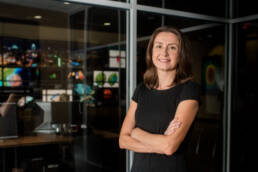As aerospace engineer Karen Willcox departs MIT to become the new director of UT’s Institute for Computational Engineering and Sciences (ICES), she inherits a world-renowned organization that has grown into one of the STEM gems on the Forty Acres. We sat down with her to learn more about her vision for the future and what truly sets ICES apart.

You’ve spent your entire career (up to this point) at MIT, but you’re a Longhorn now! What has been your impression of Austin as you’ve prepared for life in Texas?
There are actually many things about Austin that feel similar to Boston. Both have a vibrant urban area with a diverse population and a real sense of excitement about what’s happening in the city. But there is obviously a huge difference between the European feel underlying Boston and the Texan feel of Austin. We are absolutely loving the straight, fast-flowing roads and the breakfast tacos, although we are looking forward to some cooler weather!
What interested you most in making the move to UT?
ICES is simply a remarkable place with exceptional people. There is no question that this institute is a world leader. Under Tinsley Oden, ICES has had an enormous impact on the scholarly field of computational science, engineering and mathematics, but also on the many disciplines that have been revolutionized by computation. Also, when I visited UT last year, I was inspired by the vision that President Fenves and Provost McInnis have for this university. There is so much to be excited about here — from the Dell Medical School to UT’s leadership in supercomputing to opportunities to work with Austin’s tech sector — all while having the chance to be a part of a world-class engineering school.
What do you see as your key priorities as you settle into your role?
One of my most pressing priorities is to maintain and strengthen our partnerships. For example, we already enjoy a strong partnership with UT’s Texas Advanced Computing Center, home of the fastest supercomputer at any U.S. university, but I also want to build more collaborations where we have strategic opportunities, like with the Dell Medical School for computational medicine.
In addition, we want to look at how the ICES portfolio in both research and education evolves in the future. We will maintain a firm focus on computational science, engineering and math, which is and always will be the hallmark of ICES, but at the same time consider emerging areas like data science and machine learning. I am also excited about the potential for ICES’ increased role in educating undergraduate students across campus. We will not be offering a major, but the multidisciplinary nature of our organization presents a unique opportunity for students to get more involved.
And a third major priority will be strengthening the diversity of the ICES community. The intellectual diversity of having mathematicians, engineers, scientists and geoscientists together is what makes us so rich. Increased diversity in gender and race, and in perspective and socioeconomic status and background, will similarly contribute to making us even stronger.
What is the biggest opportunity for ICES as it begins the next chapter in its history? What is its biggest challenge?
ICES has so many exciting opportunities; it’s hard to single out one. I believe an enhanced role in the UT undergraduate education, in whatever form that ultimately takes, is among our biggest opportunities. ICES, in partnership with various colleges, schools and departments across campus, is well positioned to help develop the well-rounded but technically grounded leaders of tomorrow.
Our biggest challenge may be determining what our scope should be moving forward. We have to be careful not to expand in so many different directions that our core strengths become diluted. But, again, this is where our partnerships will play a critical role.
How important is cross-campus collaboration, especially with the Cockrell School, to ICES’ mission and potential for the future?
ICES already has very strong relationships across UT, enabled in large part by the direct connections through ICES faculty. The intellectual diversity of ICES’ faculty and students is one of the things that makes our institute such a vibrant place. With computation playing such a critical role in practically all disciplines across engineering, I’m particularly excited to strengthen our collaborations across the Cockrell School. There is so much quality and breadth on this campus. Opportunities for collaboration are everywhere.
How can the work of ICES impact society and quality of life in the future? And, more locally, how can the institute’s work impact the state of Texas and its citizens?
Computational science is impacting society and quality of life in incredible ways, and ICES research is at the forefront. For example, Cockrell School professor Tom Hughes is leading the way in computational medicine with modeling that is transforming the way that heart disease is diagnosed and treated. And professor Clint Dawson works to model and forecast storm surges, providing valuable information to Texas and its cities in events like Hurricane Harvey. These are just two examples. I can give many more!
In one sentence, what makes ICES extraordinary?
ICES is one of the very few places where disciplinary barriers have truly been broken down—where engineers, scientists, mathematicians, physicians and computers come together to tackle some of the most critical problems facing our society.